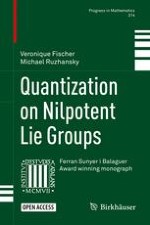Open Access 2016 | Open Access | Buch

Quantization on Nilpotent Lie Groups
verfasst von: Veronique Fischer, Michael Ruzhansky
Verlag: Springer International Publishing
Buchreihe : Progress in Mathematics
Open Access 2016 | Open Access | Buch

verfasst von: Veronique Fischer, Michael Ruzhansky
Verlag: Springer International Publishing
Buchreihe : Progress in Mathematics
This book presents a consistent development of the Kohn-Nirenberg type global quantization theory in the setting of graded nilpotent Lie groups in terms of their representations. It contains a detailed exposition of related background topics on homogeneous Lie groups, nilpotent Lie groups, and the analysis of Rockland operators on graded Lie groups together with their associated Sobolev spaces. For the specific example of the Heisenberg group the theory is illustrated in detail. In addition, the book features a brief account of the corresponding quantization theory in the setting of compact Lie groups.
The monograph is the winner of the 2014 Ferran Sunyer i Balaguer Prize.